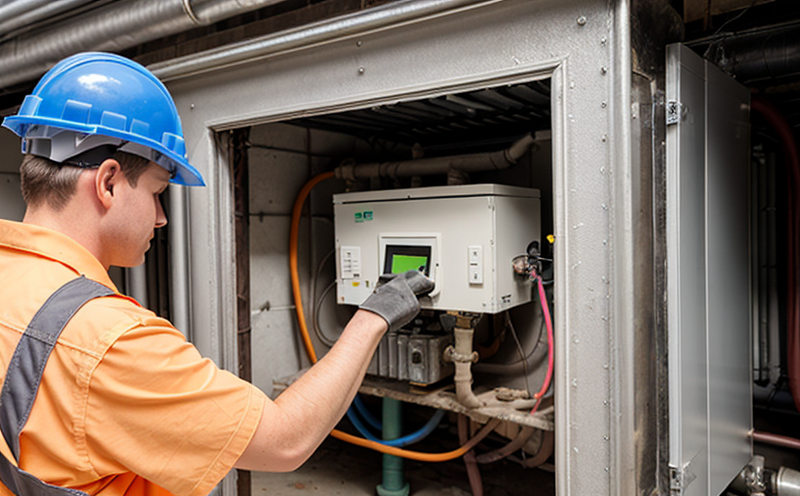Energy efficiency inspection
Evaluating energy efficiency is a critical component of modern industrial operations and sustainable practices. As quality managers, compliance officers, R&D engineers, and procurement professionals, understanding how to inspect equipment for optimal performance is essential. Energy efficiency inspections help identify inefficiencies that can lead to significant cost savings through reduced utility bills and lower carbon footprints.
The inspection process typically involves a detailed analysis of various parameters such as electrical consumption, thermal efficiency, mechanical losses, and operational pressures. These assessments are conducted using state-of-the-art instruments designed specifically for these tasks. For example, thermography cameras can detect hotspots in machinery that indicate inefficiencies or potential failures, while ammeters measure current draw to pinpoint overused components.
One of the primary goals of energy efficiency inspections is to ensure compliance with international standards like ISO 50001 and ASHRAE standards. Compliance not only helps organizations avoid penalties but also enhances their reputation as responsible corporate citizens. By adhering strictly to these guidelines, companies demonstrate a commitment to environmental stewardship which can be a significant selling point in competitive markets.
In addition to identifying areas for improvement, energy efficiency inspections provide valuable insights into the lifecycle of equipment. This information is crucial for maintenance planning and budget allocation. Regular inspections enable proactive rather than reactive approaches to maintenance, extending asset life spans and reducing downtime. Moreover, they offer opportunities to upgrade existing systems with more efficient models without major disruptions.
The importance of energy efficiency cannot be overstated in today's world where resources are becoming increasingly scarce. Organizations must continuously seek ways to minimize waste and maximize productivity. An effective inspection program should therefore include regular audits of all energy-consuming assets, including lighting fixtures, HVAC systems, industrial machinery, and data centers.
By investing in comprehensive energy efficiency inspections early on, businesses can achieve substantial long-term benefits. Not only do they reduce operational costs significantly, but they also contribute positively towards achieving broader sustainability goals set out by governments worldwide. Such initiatives are increasingly being recognized as integral parts of corporate social responsibility (CSR) programs.
It is worth noting that while energy efficiency inspections focus primarily on reducing consumption levels, they also play a vital role in enhancing overall system performance. Improved efficiencies translate directly into better productivity rates and higher quality outputs across various sectors including manufacturing, logistics, hospitality, healthcare, etc.
In conclusion, conducting thorough energy efficiency inspections is not just beneficial; it's imperative for any organization serious about sustainability and cost management. With the right tools and expertise, these assessments can lead to significant improvements in both operational effectiveness and environmental impact.
Benefits
Reduces operational costs significantly by identifying waste points early on.
Enhances overall system performance resulting in better productivity rates and higher quality outputs.
Complies with international standards ensuring regulatory compliance which can prevent potential fines.
Extends asset lifespans through proactive maintenance strategies reducing the need for premature replacements.
Customer Impact and Satisfaction
Customers benefit greatly from energy efficiency inspections as it translates into tangible savings on their utility bills. By adopting more efficient practices, businesses can pass these cost reductions onto consumers in various forms such as lower prices or improved services. Additionally, satisfied customers are more likely to recommend the service provider to others, fostering word-of-mouth marketing.
Moreover, there's an increasing trend among consumers towards environmentally friendly products and services. Companies that demonstrate a proactive approach toward sustainability will find themselves better positioned in competitive markets. This is particularly true for industries like hospitality where guest satisfaction plays a crucial role in business success.
In summary, energy efficiency inspections offer multiple advantages not only to the inspected entities but also extend positive impacts downstream affecting end-users directly.
Competitive Advantage and Market Impact
Implementing robust energy efficiency inspection programs gives organizations a significant competitive edge over their counterparts. In sectors such as manufacturing, logistics, and hospitality where resource consumption is high, being seen as leaders in sustainability can differentiate brands from competitors. Customers increasingly favor companies that prioritize environmental responsibility.
The market landscape is evolving rapidly with growing emphasis on green credentials. Organizations that lag behind risk falling out of favor not only among environmentally conscious consumers but also regulatory bodies who enforce stricter standards over time. By staying ahead of trends and implementing stringent energy management practices, firms can secure their place in the future economy.
Furthermore, participating in initiatives aimed at improving energy efficiency also opens doors to new business opportunities. For instance, many governments offer incentives for companies that invest in sustainable technologies or adopt green practices. Partnering with such entities could yield additional revenue streams and strengthen brand loyalty among customers.





